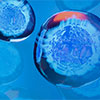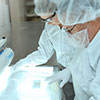BIOTIUM, INC
Supplier:
Biotium
Description:
This MAb recognizes TGF beta 1, 2 and 3. Three TGF betas have been identified in mammals. TGF beta 1, TGF beta 2 and TGF beta 3 are each synthesized as precursor proteins that are very similar in that each is cleaved to yield a 112 amino acid polypeptide that remains associated with the latent portion of the molecules. Biologically active TGF beta requires dimerization of the monomers (usually homodimers) and release of the latent peptide portion. Overall, the mature region of the TGF beta 3 protein has approximately 80% identity to the mature region of both TGF beta 1 and TGF beta 2. However, the NH2 terminals or precursor regions of their molecules share only 27% sequence identity. TGF betas inhibit the growth of epithelial cells and stimulate the growth of mesenchymal cells.
Supplier:
Biotium
Description:
This antibody recognizes a protein of ~55 kDa, identified as SOX10. This MAb is highly specific and does not cross-react with other members of the SOX-family. SOX genes comprise a family of genes that are related to the mammalian sex-determining gene SRY. These genes similarly contain sequences that encode for the HMG-box domain, which is responsible for the sequence-specific DNA-binding activity. SOX-10 is a sensitive marker of melanoma, including conventional, spindled, and desmoplastic subtypes. It is expressed by metastatic melanomas and nodal capsular nevus in sentinel lymph nodes, but not by other lymph node components such as dendritic cells, which usually express S100 protein. Commonly used melanoma markers, such as anti-HMB-45 and anti-Melan-A, are poorly expressed in desmoplastic melanomas while SOX-10 is moderately to strongly expressed in desmoplastic melanomas. SOX-10 is considered as a very reliable marker for recognizing residual desmoplastic melanomas. In normal tissues, it is expressed in Schwann cells, melanocytes, and myoepithelial cells of salivary, bronchial and mammary glands. SOX-10 expression is also observed in mast cells.
CF® dyes are Biotium's next-generation fluorescent dyes. CF®594 is a deep red fluorescent dye (Ex/Em 593/614 nm). It yields the brightest conjugates among spectrally similar dyes, and has excellent photostability.
Supplier:
Biotium
Description:
WT1 (Wilm's Tumor 1), Monoclonal antibody, Clone: WT1/857, Host: Mouse, Species reactivity: Mouse, Rat, Human, Isotype: IgG1, kappa, Conjugate: CF568, Immunogen: Recombinant protein corresponding to residues 1-181 of human WT1, Synonyms: WT1; AWT1; FWT1, Size: 100uL
Supplier:
Biotium
Description:
CD2 interacts through its amino-terminal domain with the extracellular domain of CD58 (also designated CD2 ligand) to mediate cell adhesion. CD2/CD58 binding can enhance antigen-specific T cell activation. CD2 is a transmembrane glycoprotein that is expressed on peripheral blood T lymphocytes, NK cells and thymocytes. CD58 is a heavily glycosylated protein with a broad tissue distribution in hematopoietic and other cells, including endothelium. Interaction between CD2 and its counter receptor LFA3 (CD58) on opposing cells optimizes immune system recognition, thereby facilitating communication between helper T lymphocytes and antigen-presenting cells, as well as between cytolytic effectors and target cells.
CF® dyes are Biotium's next-generation fluorescent dyes. CF®594 is a deep red fluorescent dye (Ex/Em 593/614 nm). It yields the brightest conjugates among spectrally similar dyes, and has excellent photostability.
Catalog Number:
(89139-052)
Supplier:
Biotium
Description:
Ethidium Homodimer, first developed by Dr. Le Pecq and his colleagues, is a high-affinity fluorescent nucleic acid stain. It binds to both DNA and RNA in a sequence-independent manner and with a >30-fold fluorescence enhancement. The DNA binding of each Ethidium Homodimer covers four base pairs and is believed to occur by intercalation. Because the dye is highly positively charged, it cannot cross cell membranes to stain living cells. It is useful for detecting nucleic acids in solution, or for selectively staining dead cells with damaged plasma membranes.
Supplier:
Biotium
Description:
Anti-Phosphotyrosine Mouse Monoclonal Antibody (CF640R) [clone: PY20]
Catalog Number:
(75919-388)
Supplier:
Biotium
Description:
Anti-KRT18 Mouse Monoclonal Antibody [clone: DA7]
Supplier:
Biotium
Description:
CD45RB Monoclonal antibody, Clone: PTPRC/1132, Host: Mouse, Species reactivity: Human, Isotype: IgG1, kappa, Conjugate: CF488A, Immunogen: Recom full-length human CD45RB protein, Synonyms: B220, CD45R, Application: IF, IHC, WB, FC, Size: 100uL
Supplier:
Biotium
Description:
CF543 antibodies are affinity purified antibodies labeled with orange fluorescent CF543 dye. CF543 is optimized for the 543 laser line and is significantly brighter than AlexaFluor 546.
Catalog Number:
(89493-470)
Supplier:
Biotium
Description:
Anti-IgG Goat Polyclonal Antibody (CF™ 350)
Supplier:
Biotium
Description:
Chromogranin A is present in neuroendocrine cells throughout the body, including the neuroendocrine cells of the large and small intestine, adrenal medulla and pancreatic islets. It is an excellent marker for carcinoid tumors, pheochromocytomas, paragangliomas, and other neuroendocrine tumors. Co-expression of chromogranin A and neuron specific enolase (NSE) is common in neuroendocrine neoplasms. Reportedly, co-expression of certain keratins and chromogranin indicates neuroendocrine lineage. The presence of strong anti-chromogranin staining and absence of anti-keratin staining should raise the possibility of paraganglioma. The co-expression of chromogranin and NSE is typical of neuroendocrine neoplasms. Most pituitary adenomas and prolactinomas readily express chromogranin.
CF® dyes are Biotium's next-generation fluorescent dyes. CF®647 is a far-red fluorescent dye (Ex/Em 650/665 nm) with excellent brightness. It also is compatible with super-resolution imaging by STORM.
Supplier:
Biotium
Description:
with an orange-red fluorescent dye CF555, one of an outstanding series of CF dyes developed by Biotium. CF dyes are superior for antibody labeling by having combined advantages in brightness, photostability, and specificity.
Supplier:
Biotium
Description:
PTH / Parathyroid Hormone (N-Terminal), Monoclonal antibody, Clone: PTH/1173, Host: Mouse, Species reactivity: Human, Isotype: IgG2b, kappa, Conjugate: CF594, Immunogen: synthetic peptide from N-terminal of PTH polypeptide, Synonyms: Parathyrin, Size: 500uL
Supplier:
Biotium
Description:
TAG-72 / CA72.4, Monoclonal antibody, Clone: CC49, Host: Mouse, Species reactivity: Human, Hamster, Dog, Cow, Rat, Isotype: IgG1, kappa, Conjugate: CF405S, Immunogen: Membrane-enriched fraction of breast carcinoma, Synonyms: CA72.4, Size: 100uL
Supplier:
Biotium
Description:
CD68 Monoclonal antibody, Clone: LAMP4/824, Host: Mouse, Species reactivity: Human, Isotype: IgG2a, kappa, Conjugate: biotin, Immunogen: Recom human LAMP4 protein, Synonyms: GP110, LAMP4, Application: IF, IHC, FC, Size: 500 uL
Supplier:
Biotium
Description:
This antibody reacts with human CD59, a 20 kDa glycosyl phosphatidyl-inositol (GPI)-anchored cell surface protein. CD59 regulates complement-mediated cell lysis, and it is involved in lymphocyte signal transduction. This protein is a potent inhibitor of the complement membrane attack complex, whereby it binds complement C8 and/or C9 during the assembly of this complex, thereby inhibiting the incorporation of multiple copies of C9 into the complex, which is necessary for osmolytic pore formation. It inhibits formation of MAC, thus protecting cells from complement-mediated lysis. Genetic defects in GPI-anchor attachment, that cause a reduction or loss of CD59 and CD55 on erythrocytes produce the symptoms of the disease paroxysmal hemoglobinuria (PNH). This MAb is useful for study on GPI-anchored proteins, PNH and CD59 functions. CD59 is widely distributed on cells in all tissues. The expression of CD59 on erythrocytes is important for their survival.
CF® dyes are Biotium's next-generation fluorescent dyes. CF®594 is a deep red fluorescent dye (Ex/Em 593/614 nm). It yields the brightest conjugates among spectrally similar dyes, and has excellent photostability.
Inquire for Price
Stock for this item is limited, but may be available in a warehouse close to you. Please make sure that you are logged in to the site so that available stock can be displayed. If the
Stock for this item is limited, but may be available in a warehouse close to you. Please make sure that you are logged in to the site so that available stock can be displayed. If the
You must log in to order restricted items. We request that you provide the required business documentation to purchase this product for the first time.
To order chemicals, medical devices, or other restricted products please provide identification that includes your business name and shipping address via email CMD_NA@vwr.com or fax 484.881.5997 referencing your VWR account number . Acceptable forms of identification are:
-Additional Documentation May be needed to purchase this item. A VWR representative will contact you if needed.
This product has been blocked by your organization. Please contact your purchasing department for more information.
The original product is no longer available. The replacement shown is available.
This product is currently unavailable but limited stock may be available in our extended warehouse network. Please call 1-800-932-5000 and a VWR Customer Service Representative will help you.
|
|||||||||


































